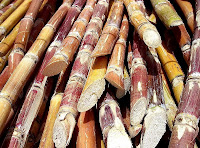This blog has moved to a new website
Nutrition, Health & Wellness
It is found to grow from 2 to 6 meters in height and the stalks are rich in sugary juice. Sugar cane has been hybrid and many varieties have been evolved having greater yields of sugar. It is grown in more than 100 countries and about 1600 million metric tons of cane is produced all over the world.
About 50% of the world sugarcane production is from Brazil and India. In India crystallized sugar was mentioned more than 5000 years ago. During the 7th century, sugarcane was introduced to North Africa, West Asia, Middle East and Mediterranean regions. Portuguese and Andalusians (South Spain) introduced sugarcane to Americas.
Sugarcane requires tropical or temperate climate with sufficient rain fall and humidity. Though it produces seeds it is best propagated by stem cuttings to maintain hybrid vigor. At the processing plant the cane stalks are washed, chopped and shredded to smaller pieces.

The shredded cane is repeatedly mixed with water and crushed between rollers to squeeze out the sugar juice. The solid wastes are called bagasse and are used as fuel. The juice is usually of 10-15 percent sucrose concentration and lime is added to it to increase pH to arrest fermentation and to precipitate suspended waste.
In multiple-effect evaporator, the clarified juice is concentrated to 60 percent sucrose syrup. Under vacuum this syrup is further concentrated for its supersaturation. This supersaturated syrup is seeded with sugar crystals and cooled to crystallize sugar from the syrup. By centrifuging the crystalline sucrose is separated from the molasses.
This process is repeated again and again to recover more sugar till no more crystals are forming. However the remnant molasses may still contain 20-30 percent sucrose and 25 percent glucose and fructose. The raw sucrose, which may appear yellow or brown is further refined to produce white crystalline cane sugar.
No comments:
Post a Comment